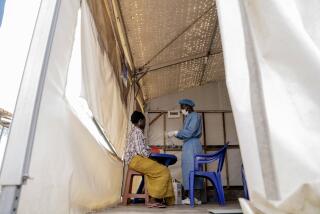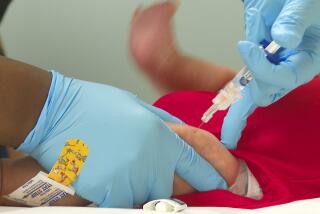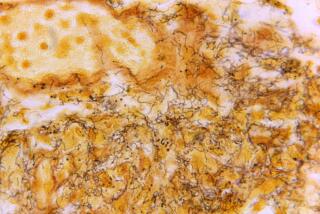U.S. suffering worst whooping cough outbreak since 1959, CDC says
The United States is on track to have the highest number of whooping cough cases since 1959, the Centers for Disease Control and Prevention said Thursday. Already, there have been nearly 18,000 cases of the disease, formally known as pertussis, reported nationwide this year, more than twice as many as at this point in 2011, said Dr. Anne Schuchat, director of CDC’s National Center for Immunization and Respiratory Diseases. There have been nine deaths so far, all of them in infants. In 2010, there were more than 27,000 cases and 27 deaths, 25 of them in infants.
About half the cases this year are in infants under the age of 3 months -- not surprising because they are too young to have been vaccinated. Protection of such children relies on vaccination of pregnant women and others who will come into contact with the infants and, unfortunately, the rates of such vaccinations are not as high as they could be. But an unusually high number of the new cases are among teenagers ages 13 and 14, a group that would normally not be expected to contract the bacterium at such a rate. That suggests, Schuchat said, that the effectiveness of the vaccine is waning a few years after vaccination.
The good news is that the severity of the disease is lower in individuals who have received a vaccination against it and contract it anyway, and they are less infectious than the unvaccinated.
The outbreak is particularly severe in Washington state, where pertussis was declared to be epidemic in April, according to a report in CDC’s Morbidity and Mortality Weekly Report. The state is seeing the largest number of cases since the early 1940s, said Mary Selecky, secretary of the Washington State Department of Health. By the end of last week, the state had more than 3,000 cases, she said -- more than three times the number observed all last year. And “we suspect there are people who have it that we don’t know about,” she added. So far, there have been no deaths in the state this year, however. The profile of victims is very similar to that observed nationally.
The United States used to use a pertussis vaccine that was made from killed cells of the Bordetella pertussis bacterium -- and much of the world still does. But that vaccine produced side effects, such as fever and pain and redness at the injection site. It was also associated with rare but serious neurological problems, although studies attempting to confirm that link “have not been consistent,” Schuchat said. In 1997, the U.S. switched to newer, so-called acellular vaccines which used proteins from the surface of the bacterium. This vaccine has fewer local side effects, she said, “but the question of neurological issues is not so clear.” This vaccine produces 95% protection within two years after administration, but recent studies in California have shown that within five years, the protection drops to 70%. “That may be why we are seeing this increase,” she said.
There is no evidence that refusal of parents to have their children vaccinated is a driving force in the outbreak, Schuchat said. But she added that there is a strong need for all adults who may come in contact with infants to get booster shots to protect the youngsters.
Twitter/@LATMaugh






